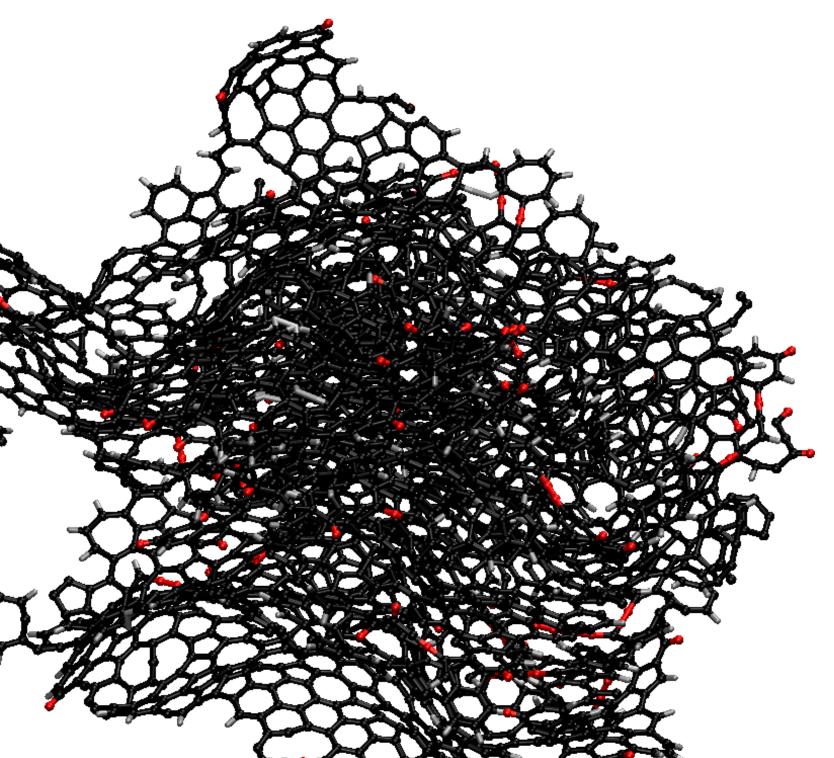Char Combustion Mechanism
Research within CRC/TRR 129 Oxyflame
Our efforts together with the Hättig-group in Project A7 are focused on the atomistic level of the heterogeneous char combustion. Note that combustion mechanisms in the gas-phase of small molecules like methane are very well understood and accurate kinetic models are available, which are based also on accurate theoretical results. However, for the heterogeneous combustion process, this is not the case and the actual mechanism behind a lumped reaction "C + 1/2 O2 --> C(O)", indicating the formation of some surface bound oxygen in most of the available kinetic models, is entirely unknown. AS the overall simulation framework in Oxyflame, also the atomisitc part is in itself a multiscale approach and we use methods ranging from reactive MD (ReaxFF) to correlated ab initio methods. Whereas the Hättig-group focus on electronic structure calculations, our expertise are reactive and non-reacitve force field simulations. We develop these methods for the char combustion, but the methods could be generalized to pyrolysis as well as other heterogeneous reactions.

Research Topics:

Automated Reaction Mechanism Detection
We develop a computational workflow to automatically determine a heterogeneous reaction mechanism (currently targeted on char combustion) by an automated screening of MD trajectories generated by a reactive force field (ReaxFF) with our findR code. Reaction events are stored in an SQL database and unique reactions are further optimized by electronic structure methods (DFT, Coupled Cluster) to produce rate parameter and thermodynamic data. (read more)

Atomistic Char Models
Char is a complex amorphous material that forms by the pyrolysis of coal. It basically consists of defect rich graphitic domains with functional groups. We develop methods to construct such atomistic char structures using experimental data from experiment. (read more)
About CRC/TRR 129 Oxyflame

The Collaborative Research Center CCR/TRR 129 Oxyflame is a multi scale research cooperation of the RWTH Aachen, the Ruhr-University Bochum and the TU Darmstadt. The main goal is to develop methods and models to describe the combustion of solid fuels in oxyfuel conditions.
A combustion process under oxyfuel conditions allows reaching high flame temperatures. This is achieved by burning with high oxygen concentrations. The temperature can be varied by the amount of recirculated flue gas, which mostly contains CO and H2O . In normal power plants, the surrounding air is sucked in and blown into the furnace. 78 % of normal air is nitrogen. By replacing nitrogen with flue gas, the amount of NOx can be reduced drastically, because the only source for nitrogen is coal. Additionally, the concentration of CO2 in the flue gas is higher - due to the recirculation - than in normal power plants, which allows a more efficient CO2 separation. The combustion of coal in oxyfuel conditions is investigated to develop reliable models that allow a detailed understanding of the processes in this atmosphere, which is required to design burners and furnace chambers of power plants for oxyfuel combustion. This reduces the time for the development of new power plants by applying greater scale-up steps and fewer experiments.
The Oxyflame project is composed of three project areas A, B, and C working on three different scales. Area A focuses on micro-scale projects with the aim to determine the kinetic laws of the combustion of coal under oxyfuel conditions. In most of the groups, the pyrolysis and char burnout can be examined separately. Not only natural coals are examined but also artificial coal is produced by one of the groups.
The knowledge about the composition of the artificial coals allows inferring from the percentage of one atom type on its influence on the combustion. The kinetic data are passed on to Areas B and C. Area B is focused on the mesoscale and investigates not the particles but the particle flow and compares the combustion at different spatial scales. Here several groups are performing simulations. The experiments from Area B are then upscaled for Area C. In Area C the data from the other areas are integrated into the macro-scale simulation of oxyfuel combustion chambers. Not only the model is upscaled but also the experiments. The independent research of this Area is on radiative heat transfer of particles present in the oxyfuel combustion process.


